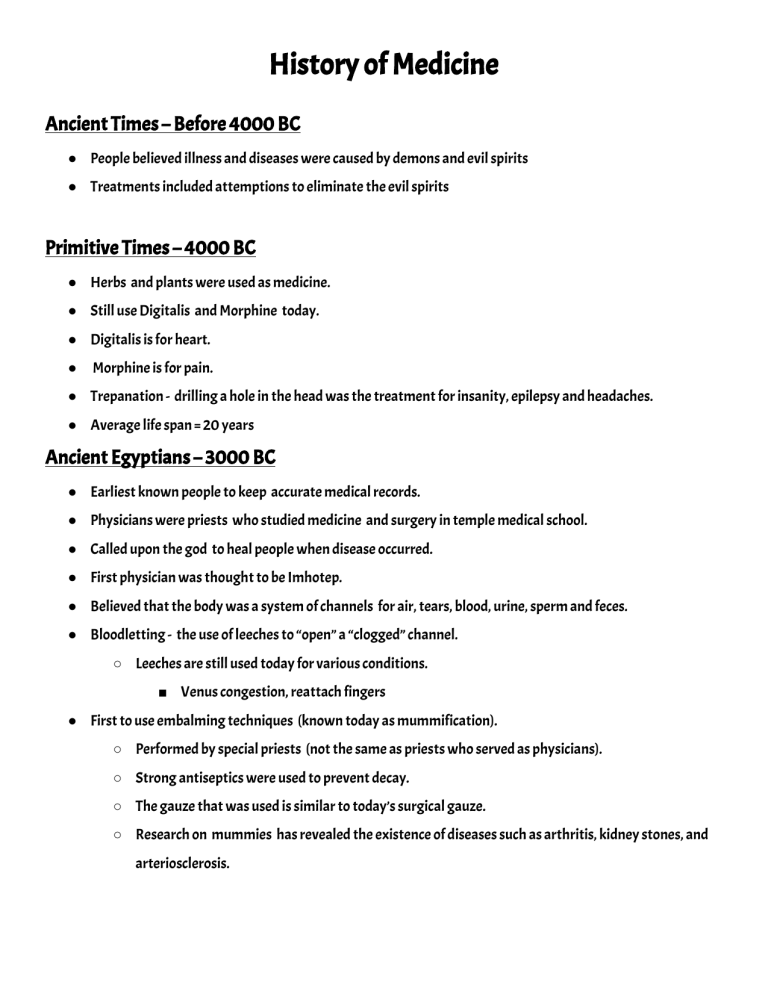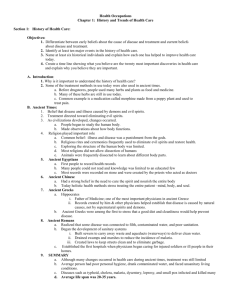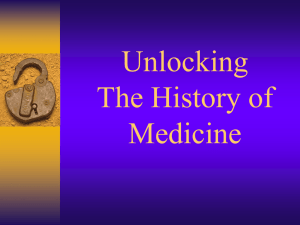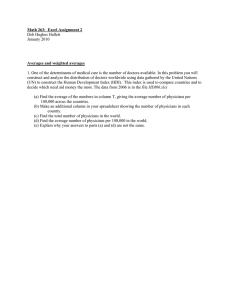
History of Medicine Ancient Times – Before 4000 BC ● People believed illness and diseases were caused by demons and evil spirits ● Treatments included attemptions to eliminate the evil spirits Primitive Times – 4000 BC ● Herbs and plants were used as medicine. ● Still use Digitalis and Morphine today. ● Digitalis is for heart. ● Morphine is for pain. ● Trepanation - drilling a hole in the head was the treatment for insanity, epilepsy and headaches. ● Average life span = 20 years Ancient Egyptians – 3000 BC ● Earliest known people to keep accurate medical records. ● Physicians were priests who studied medicine and surgery in temple medical school. ● Called upon the god to heal people when disease occurred. ● First physician was thought to be Imhotep. ● Believed that the body was a system of channels for air, tears, blood, urine, sperm and feces. ● Bloodletting - the use of leeches to “open” a “clogged” channel. ○ Leeches are still used today for various conditions. ■ Venus congestion, reattach fingers ● First to use embalming techniques (known today as mummification). ○ Performed by special priests (not the same as priests who served as physicians). ○ Strong antiseptics were used to prevent decay. ○ The gauze that was used is similar to today’s surgical gauze. ○ Research on mummies has revealed the existence of diseases such as arthritis, kidney stones, and arteriosclerosis. ● Some medical practices still used today: ○ Enemas ○ Circumcision - preceded marriage ○ Closing wounds ○ Setting fractures Ancient Chinese – 1700 BC ● Believed in the need to treat the whole body by curing the spirit and nourishing the body. ● Believed monitoring the pulse to determine the condition of the body. ● Recorded a pharmacopoeia of medications based mainly on the use of herbs. ○ Book containing directions for the identification of samples and the preparation of compound medicines. ● Acupuncture is used to relieve pain and congestion. ● Moxibustion is used to treat disease by stimulating circulation and the body’s qi ● Began to search for medical reasons for illness. ● Average life span= 20 to 30 years Ancient Greeks – 1200 BC ● Began modern medical science by observing the the human body and effects of disease. ● Believed illness was a result of natural causes. ● Stressed diet and cleanliness as ways to prevent diseases. ● Therapies we still use today: ○ Massage ○ Herbal treatment ○ Art therapy ● Important people: ○ Alcmaeon - biochemist; identified the brain as the physiological site of the senses. ○ Aristotle - dissected animals; called the founder of comparative anatomy. ● Hippocrates : called the Father of Medicine ○ Developed an organizational method to observe the human body. ○ Recorded signs and symptoms of many diseases. ○ Created a high standard of ethics, the Oath of Hippocrates , which is still used by physicians today ○ Average life span = 25 to 25 years Ancient Romans – 753 BC to 410 AD ● Aqueducts to organize medical care for injured soldiers. ● Early hospitals took place in home the of the ill people. ● Hospitals were later housed in monasteries and convents and . ● Diseases were treated with diet ,exercise , medication . ● Average life span = 25 to 35 years ● Learned from the Greeks - Began public health and sanitary systems. ○ Aqueducts carried clean water to cities . ○ Sewers to carry waste away from cities. ○ Filtering system in public baths to prevent disease . ○ Drained marshes to reduce the chance of getting ______ . ● Important Romans ○ Claudius : Physician who believed the body is regulated by 4 fluids or humors: ■ _______________________________________________________________________________. An imbalance in the fluids results in illness. ■ Dissected animals to determine ____________________ of ___________________, kidneys, and __________________. ■ Studied infectious __________________ and described symptoms of _______________________. Dark Ages – 400 to 800 AD ● The study of _________________________ was prohibited. ● Emphasis was on ____________________________________. ● Illness and disease were treated by _________________________, ______________________________, and ________________________________________. ● ______________ and ______________ provided care for sick people. Middle Ages – 800 to 1400 AD ● Interested in medical practice of _______________ and _______________ was renewed. ● Physicians began obtaining knowledge at ___________________________________ in the __________ century. ● Major diseases were ________________________, diphtheria, __________________________, typhoid, the ____________________, and malaria ● _____________________________ of the bubonic plague killed ¾ of the population of Europe and Asia. ● Arab physicians used their knowledge of _____________________ to advance _____________________________. ● Arabs began requiring physicians to pass examinations and obtain ____________________. ● Average life span = ____________________ ● Important People: ○ __________________: known as __________ Hippocrates. ■ Based _________________ on ____________________ of __________________________________ of disease. ■ _________ AD, developed criteria for distinguishing between _____________________ and ____________________. ■ Suggested blood was the cause of many infectious diseases. ■ Began use of _____________________ for sutures ● ________________________: physician in the _______ century. ○ Described the parasite that causes _______________________. Renaissance – 1350 to 1650 AD ● ___________________ of the science of medicine. ● Dissection of the ____________ allowed for a better understanding of ________________________ and ________________________. ● First chairs (____________________of _______________________) of medicine was created at _____________________________ in Cambridge, England in _____________. ● ___________________________________________________________ allowed knowledge to be spread to others. ● Average life span = ____________________ ● Important People ○ __________________________________ and _______________________________________ ■ Used dissection to draw the body more realistically. ● ________________________ ○ Published the first Anatomy Book. ● ________________________ ○ Wrote the first book on Dietetics. 16th and 17th Centuries – 1501 to 1700 ● Causes of diseases were still __________ known. ● Many people died from infections and puerperal fever (during childbirth). ● _________________________: (early pharmacists) made, prescribed and sold medications. ● Average life span = ____________________ ● Important People ○ __________________________________: French surgeon known as the _____________________________ ______________________________. ■ Established _____________________________ to bind arteries and stop bleeding. ■ Eliminated the use of boiling oil to _____________________ wounds. ■ Promoted the use of __________________ limbs. ● Anton ______________________________ ○ Invented the ________________________ in 1666. 18th Century – 1701 to 1800 ● Doctors based their _________________________________________ on the ancient beliefs of "humors," bodily "tension," or other cruder practices. ● The practice of "____________________________" with leeches to cure illness was still common practice. ● The practice of medicine caused more _________________________________________ as doctors did not sterilize their hands or instruments. ● __________________________________ were better doctors than learned physicians were. ● The most commonly used medicines were botanical. ● The most widely read material were the "herbals" catalogues, which explained where and how healing herbs grew and explained their uses. ● The medicines prescribed for ailments were just as bad as the illness itself. In Europe anything and everything was used in the mixing and making of drugs. ● Important People ○ Gabriel ____________________________: created the first ____________________________ in 1714. ○ ____________________________: English surgeon who established surgical procedures. ○ Benjamin ___________________________: invented bifocals for _____________________. ○ ______________________________: prescribed __________ juice and vitamin _____ to prevent _______________ in 1795. ○ ________________________: developed a vaccine for ____________________ in 1796. ■ World’s first vaccine. 19th Century – 1801 to 1900 ● The industrial revolution took place, resulting in major progress in _____________________________________. ○ Ready access to _______________. ○ ______________________________________________________________. ● Formal training for ________________________. ● ____________________ became active participants in medicine. ● Treatments became more specific ___________________________________________________. ● Practitioners focused on ____________________________ that was generally based on causative information. ● _____________________________________________________ until 1895 and were the first true diagnostic tool. ● Health care may have included a ________________________________________________, or just a trip to the apothecary. ● _______________________________ was not used in hospitals until the 1870s. ● Two perspectives on the body in 19th century America ○ __________________________________________ were related to each other. ○ The inputs and outputs of the body were __________________________________________________. ● _________________________________________ were designed to help the body re-achieve its proper balance by releasing bodily elements ● Important People ○ James ________________________: performed the first ___________________________________ in 1818. ○ Rene ____________________: invented the first _______________________ in 1819. ○ Gregory ______________________: established principles of _______________ and dominant/recessive patterns. ○ ________________________________________________: known as the Founder of _______________________________________________________. ■ Began the professional education of nurses ■ Established nursing units during Crimean War in 1854. ■ Opened ____________________________________________for nurses at __________________ Hospital in London in 1860. ● Ignaz _______________________ ○ Encouraged physicians to _________________________ with lime after performing _______________ and before delivering ____________ to prevent fevers. ● o Elizabeth ________________________ ○ First female _________________ in the US in __________. ● ________________________: started using ______________________________ and antiseptics during surgery to prevent infection in 1865. ● __________________________: founded the _________________________________________ in 1881. ● Louis ___________________ ○ Proved microorganisms cause diseases,. ○ ________________________ milk to kill bacteria. ○ Created ______________________ vaccine in 1885. ● Dimitri _______________________________: discovered ____________________ in 1892. ● Wilhelm _________________________: discovered Roentgenograms (__________) in 1895. ● _______________________________: developed a vaccine for Typhoid Fever in __________. 20th Century – 1901 to 2000 ● Average life expectancy went from _____________________________________. ● This dramatic increase in life expectancy is largely due to several _________________________________ during this time ● First kidney dialysis machine was developed in __________. ● First heart-lung machine used for open heart surgery in __________. ● Physicians used ______________________________ to diagnose inherited diseases before birth in 1975. ● The first baby was born using in __________________________________ in 1978. ● _______________ Immune Deficiency Syndrome (__________) was identified in __________. ● _______________ Immunodeficiency Virus (_____) was identified in __________. ● First __________ therapy to treat diseases occurred in __________. ● _________________ was cloned in 1997. ● ______________________________________ programs to prevent diseases ● Advances in __________________________________________ (MRI, CT scan) ● Human genome project will lead to a much better understanding of the _________________________________ __________________________________________. ● Health insurance plans were created to ____________________________________. ● Important People ○ _______________________: demonstrated that mosquitoes carry yellow fever in __________. ○ Carl ____________________: classified the______ blood groups in 1901. ○ Dr. Elie ____________________: identified how __________ blood cells protect against diseases. ○ ________________________: isolated radium in 1910. ○ ________________________: formed the basis for ____________________ and ____________________. ○ Frederick ____________________ and Charles __________: discovered and used __________ to treat ______________ in 1922. ○ Sir Alexander ____________________: discovered _______________ in 1928. ○ Dr. George ____________________: developed the Pap Test to detect ________________ cancer in females. ○ Frances __________ and James __________: described the structure of ________ in 1953. ○ Jonas ___________: developed the __________ vaccine using __________ polio virus in 1952. ○ ____________________: developed an oral __________ virus polio vaccine in the mid-1950s. ○ ____________________: performed the first successful _____________ transplant in 1954. ○ ______________________________: performed the first successful __________ transplant in 1968. ○ Dr. William _______________: implanted the first artificial __________, the Jarvick-7, in 1982. 21st Century (2001-Present) ● The potential for advancement is ___________________________. ○ Computers and rapid communication allows __________________________________________________ _____________________________________. ● Use of ________________________________________. ● Anti-Smoking Laws __________________. ○ ____________________________________ to secondhand smoke ○ ___________________________________ of cases of lung cancer ● Targeted Cancer Therapies ○ ________________________________________________________. ● Laparoscopic Surgeries Improved ○ ______________________________________________________. ○ Increase in natural orifice procedures ● Genetic research is becoming ______________________. ○ Human Genome Project ■ __________________________________ all the genes of the human genome ■ Completed April 2003 “___________________________________” ● Stem-Cell Research ○ 2006 - “mini-liver” generated from human cord blood stem cells in the UK ○ 2007 - Scientists discover how to use human skin cells to create embryonic stem cells. ● 2005 - First partial ______________________________. ● 2010 - First full _______________________________. ● 2006 - Vaccine for _________ (human papilloma virus) ● 2006 - HIV treatment cocktail approved ● Combined ______________________________________________ and made treatment protocol easier to follow. ● 2014 - FDA approves human clinical trials in the USA for _______________________________________________ ____________________________.






